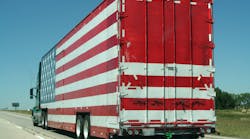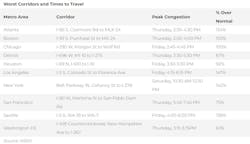As the roadways clog with travelers, prioritizing safety is of heightened importance for commercial and passenger vehicles alike.
The motor club AAA predicts 47.9 million people will travel 50 miles or more from home this weekend, and car travel is expected to set a new record, with 42 million people on the roads, despite record fuel prices. Nationwide travel time is expected to increase by 50%, although with less congestion on July 3 and July 4 as people celebrate Independence Day.
Plan your routes
When traveling, people may be unfamiliar with parts of the roadway, increasing the risk of accidents—be especially wary of out-of-state plates. Planning your route can help you avoid unwelcome surprises. If possible, schedule your departure and arrival times to avoid peak traffic. Also schedule breaks according to industry rules.
Although parking your truck is a persistent problem, make sure your plan includes a safe place to sleep. AAA calculates that drowsy driving is a factor in one of five fatal crashes. The National Highway Traffic Safety Administration (NHTSA) estimates that in 2017 drowsy driving was responsible for 91,000 crashes, resulting in 50,000 injuries and almost 800 deaths.
See also: Adding new safety technology requires driver buy-in
Check your equipment
In addition to campers driving in rural parts of the country, wildlife is a concern as deer birthing season resumed in June. Staying alert and ensuring you have the proper equipment to see on the road is a must.
Because summer storms will bring overcast skies and heavy rain, visibility while driving may be a challenge. LED lights offer a wider scope of landscapes compared to halogen lights. Halogen lights offer a clear scope in front of vehicles, and while they have a limited range of side views, they last about 500 hours and are more energy efficient than LEDs. Mounting cameras can cover blind spots, providing you with additional coverage, not to mention a legal defense in case of collisions.
There have been advances in mirrors that are beneficial to drivers. Different mirrors have different functions, ranging from folding mirrors and towing mirrors to blind-spot mirrors. Others contain built-in lights to help better see objects.
Roads can be especially slick in summer rains. Under high temperatures, it’s possible for pavement to release more of the oils that have accumulated in it over time. When it starts to rain, the oils mix with rainwater to create slippery surfaces, especially for the first 10 to 15 minutes of precipitation. It’s at this crucial point that traction is more important than ever.
See also: Saving with tire section repairs
On dual-tire wheel-ends, even a difference of only 5 psi between two tires on the same wheel-end can increase tire wear, thereby lessening traction. Ninety percent of tire blowouts are caused by underinflation. Additionally, research has shown that just 10% underinflation can reduce fuel economy by 1.5%.
Tire wear and slippery conditions can also impair your brakes’ ability to stop your truck, so make sure to check your brakes frequently. The Commercial Vehicle Safety Alliance (CVSA) will conduct its annual Brake Safety Week later this summer, Aug. 21-27, but there’s no reason you can’t start inspecting now.
Winter weather can damage roadways, and when the snow melts, potholes can be left behind. This road damage can worsen due to increased traffic. Checking suspension by performing a “bounce test” lets drivers know if shocks are wearing out. If the vehicle bounces more than twice, it’s time for a replacement.
Take care of yourself
For your own safety, make sure your air conditioning is not making strange or rattling noises, or emitting unusual odors, because those are signs that your HVAC system needs servicing. When sitting in an outdoor temperature of 86 degrees Fahrenheit, interior vehicle temperatures can rise to 134 to 154 degrees, according to researchers. Consider installing a battery HVAC system if you haven’t already.
Cellphone use is restricted by the Federal Motor Carrier Safety Administration (FMCSA)—and for good reason. Distracted driving killed more than 3,100 people in 2020. Even using Bluetooth headsets can increase the risk of collisions, so avoid unnecessary communications. If it’s necessary to use your phone more extensively than FMCSA regulation allows, find a safe place to stop.
While safety can seem like common sense, there are enough accidents every year to prove that so-called "common sense" isn't always common. By prioritizing safety and reviewing best practices, everyone gets to enjoy Independence Day weekend.





